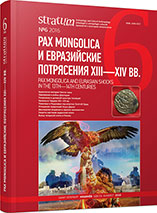Потрясения в духовной культуре половцев Восточной Европы XIII—XIV вв. (по данным археологии)
Shocks in the Western European Cumans’ Religious Culture in 13th —14th Centuries (by archaeological sources)
Author(s): Maksym V. KvitnytskyiSubject(s): History, Archaeology, Middle Ages, 13th to 14th Centuries, History of Religion
Published by: Издательский дом Stratum, Университет «Высшая антропологическая школа»
Keywords: Eastern European steppes; Cumans; religion; shamanism; Christianity
Summary/Abstract: The paper considers the problem of radical changes in the religious (spiritual) culture of the Cumans populating the Eastern European steppes in the 13th —14th centuries. Using primarily archaeological data, it examines aspects of religious culture before the collision with the Mongols and the evidence of changes that took place after the Cuman conquest. The results indicate the spread of shamanism among the Cumans, which fully confirms the facts known from written accounts. After the collision with the Mongols in the 13th century, the Cumans completely changed their religious worldview by adopting the Western Christianity. Nomadic burial grounds and settlements of the Golden Horde period found in the Eastern European steppes suggest some missionary activities and regular divine servicesamong the nomads, and tell about a massive spread of Christianity. Individual finds of stone sculpture with Christian symbols and images of details of clothing typical of the second half of the 13th —14th centuries point to transitional and adaptational processes from the old beliefs towards Christian ideology. These findings fully align with the conclusions of studies into written accounts.
Journal: Stratum plus. Археология и культурная антропология
- Issue Year: 2016
- Issue No: 6
- Page Range: 45-68
- Page Count: 24
- Language: Russian
- Content File-PDF

